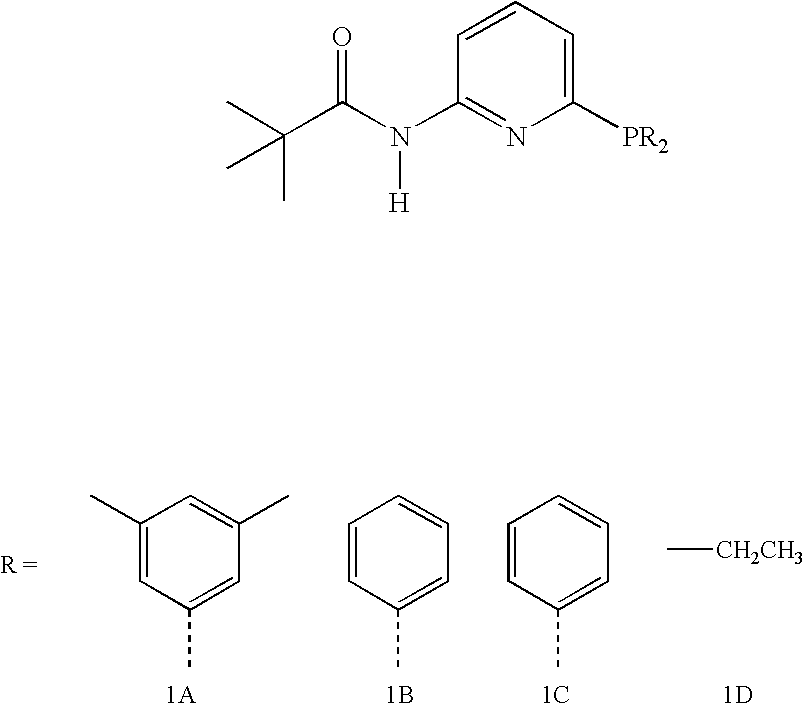Hydroformylation process
a technology of allyl alcohol and hydroformylation process, which is applied in the preparation of carbonyl compounds, physical/chemical process catalysts, organic compounds/hydrides/coordination complex catalysts, etc., can solve the problems of reducing the yield of bdo, severe adverse effect on process economics, and other co-products or byproducts, etc., to achieve the effect of high ratio of 4-hydroxybutyraldehyd
- Summary
- Abstract
- Description
- Claims
- Application Information
AI Technical Summary
Benefits of technology
Problems solved by technology
Method used
Image
Examples
example 1
Preparation of Aminopyridine Phosphines
[0031]1A, 1B, 1C, and 1D: Phosphine 1A is prepared according to the procedure described below. Phosphines 1B, 1C, and 1D are prepared using analogous procedures employing the suitable chlorophosphines.
[0032]Phosphine 1A: 6-bis(3,5-dimethylphenyl)phosphino-N-pivaloyl-2-aminopyridine.
[0033]Comparative Phosphine 1B: 6-diphenylphosphino-N-pivaloyl-2-aminopyridine.
[0034]Comparative Phosphine 1C: 6-dicyclohexylphosphino-N-pivaloyl-2-aminopyridine.
[0035]Comparative Phosphine 1D: 6-diethylphosphino-N-pivaloyl-2-aminopyridine.
[0036]
[0037]A solution of n-butyl lithium in hexanes (1.6 M, 2.9 mL, 4.6 mmol) is added to a solution of 6-bromo-2-N-trifluoroacetylaminopyridine (0.62 g, 2.3 mmol) in tetrahydrofuran (15 mL) at −100° C. After stirring at constant temperature for 90 minutes, a solution of bis(3,5-dimethylphenyl)chlorophosphine (501 μL, 2.5 mmol) in tetrahydrofuran (4 mL) is introduced drop-wise and stirred for 90 minutes at −100° C. The solution is...
example 2
Preparation of Isoquinolone Phosphines
[0039]2A, 2B, 2C and 2D: Phosphine 2A is prepared according to the procedure described below. Phosphines 2B, 2C, and 2D are prepared using analogous procedures employing the suitable triphosphines.
[0040]Phosphine 2A: 3-bis(3,5-dimethylphenyl)phosphino-2H-isoquinolin-1-one.
[0041]Comparative Phosphine 2B: 3-diphenylphosphino-2H-isoquinolin-1-one.
[0042]Comparative Phosphine 2C: 3-dicyclohexylphosphino-2H-isoquinolin-1-one.
[0043]Comparative Phosphine 2D: 3-diethylphosphino-2H-isoquinolin-1-one.
[0044]
[0045]Potassium tert-butoxide (2.2 g, 19.3 mmol) is added to a solution of 1,3-dichloroisoquinoline (3.2 g, 16.12 mmol) in toluene (40 mL). The solution is then heated at reflux, cooled to ambient temperature, and filtered through a silica pad. The filtrate is concentrated under reduced pressure and the residual yellow liquid is purified by distillation (210° C., 0.1 mm Hg), yielding 1-tert-butoxy-3-chloroisoquinoline (3.4 g, 89%).
[0046]At −78° C., sodiu...
example 3
Hydroformylation Reaction Using Phosphines
[0048]Allyl alcohol is hydroformylated using phosphines 1A-1D and 2A-2D according to the following procedure:
[0049]A solution of phosphine (0.12 mmol) in dry degassed isopropanol solvent (4 mL) is added under a stream of argon or nitrogen to [Rh(CO)2(acac)] (0.04 mmol) under an argon atmosphere. The resulting solution is transferred in a gastight syringe to a 25-mL autoclave under an argon atmosphere. The autoclave is flushed twice with a 1:1 CO / H2 mixture and then pressurized to 30 bar with the CO / H2 mixture. The autoclave is then heated to 90° C. with stirring, the pressure is increased to 39 bars, allyl alcohol (1 mL) is then injected from a sidearm, and the autoclave pressurized to 40 bar with the CO / H2 mixture. The autoclave is kept at a constant pressure of 40 bar, and the gas uptake of the reaction is monitored in a ballast vessel from which the gas is delivered. When there is no further gas uptake, the autoclave is cooled and depress...
PUM
| Property | Measurement | Unit |
|---|---|---|
| pressures | aaaaa | aaaaa |
| pressures | aaaaa | aaaaa |
| pressures | aaaaa | aaaaa |
Abstract
Description
Claims
Application Information
 Login to View More
Login to View More - R&D
- Intellectual Property
- Life Sciences
- Materials
- Tech Scout
- Unparalleled Data Quality
- Higher Quality Content
- 60% Fewer Hallucinations
Browse by: Latest US Patents, China's latest patents, Technical Efficacy Thesaurus, Application Domain, Technology Topic, Popular Technical Reports.
© 2025 PatSnap. All rights reserved.Legal|Privacy policy|Modern Slavery Act Transparency Statement|Sitemap|About US| Contact US: help@patsnap.com



